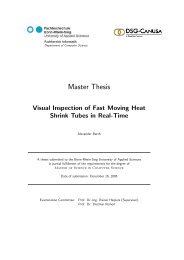Master Thesis - Hochschule Bonn-Rhein-Sieg
Master Thesis - Hochschule Bonn-Rhein-Sieg
Master Thesis - Hochschule Bonn-Rhein-Sieg
You also want an ePaper? Increase the reach of your titles
YUMPU automatically turns print PDFs into web optimized ePapers that Google loves.
5. Algorithms <strong>Master</strong> <strong>Thesis</strong> Björn Ostermann page 75 of 126<br />
Figure 52: Fluctuation noise after the offset filter (12 cm) and plausibility filter<br />
as shown in Figure 24<br />
5.2.3 Adding a virtual robot base<br />
As described in chapter 4.3.4 the base of the robot is not detected as an intrusion, because it can not be<br />
removed during the background acquisition. Thus a virtual base has to be created. It is added to every<br />
intrusion map after filtering, because otherwise the filter would remove it as noise.<br />
Since the robot base is a near perfect circle the virtual base can be simulated by a circle. It is entered<br />
by the user by its centre point and its radius (see chapter 4.3.4) in the GUI.<br />
To be able to quickly add the base to the intrusion map in every loop, the virtual robot base is<br />
computed from the user’s values after their entry and stored in a binary two dimensional array (see<br />
Figure 53a). Since the base is to be a circle and the array a rectangle, each value in the array has to<br />
indicate whether or not it is part of the base (inside or outside the circle).<br />
a) b)<br />
Inside camera‘s view<br />
Outside<br />
virtual<br />
robot<br />
base<br />
Figure 53: a) Creating the virtual robot base, blue circle: robot base radius, blue cross: centre of robot<br />
base, red square: not robot base, green square: robot base<br />
b) Virtual base, added in the program (see Figure 26)














